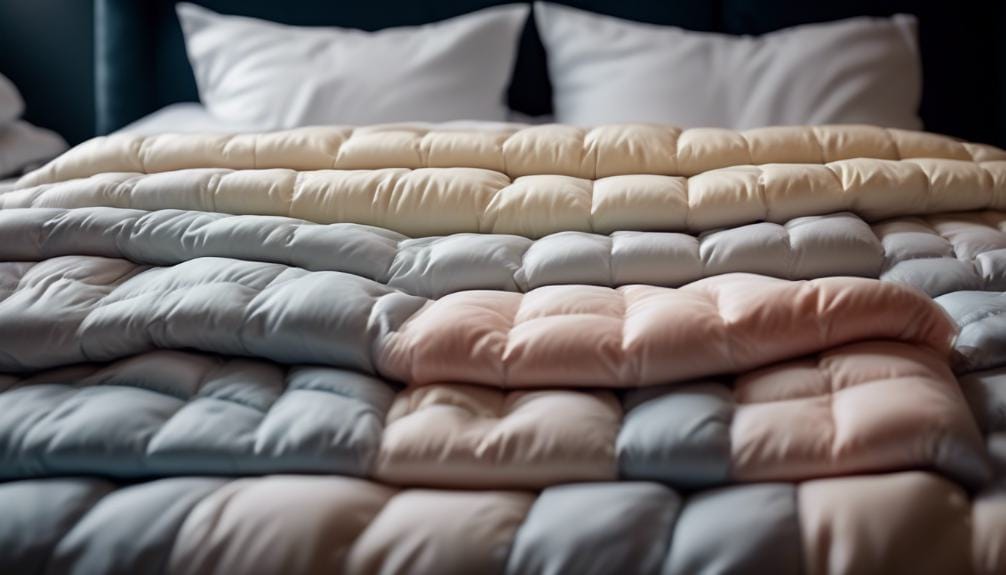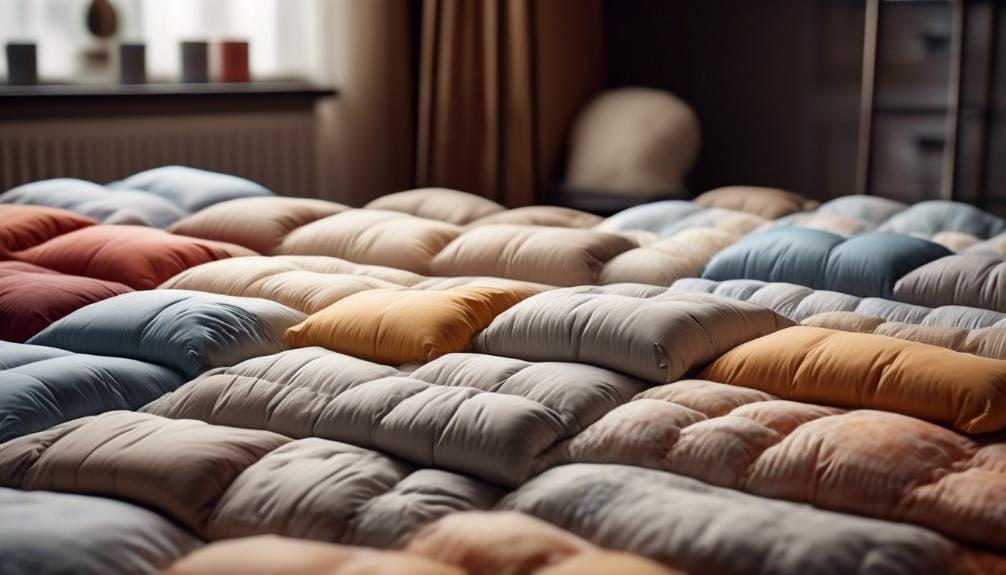What Duvet for Summer? Choosing the Perfect Warmth Level
Are you tired of waking up in a sweaty mess during those warm summer nights? The key to a comfortable night’s sleep lies in choosing the perfect duvet with the right warmth level.
But with so many options available, how do you know which one is best for you? From understanding warmth levels and exploring different types of fillings to selecting the right warmth class, there are several factors to consider.
Let’s dive into the world of duvets and discover how to ensure a restful and cool night’s sleep during the summer months.
Key Takeaways
- Lower Tog rating (1 to 4.5) is ideal for summer nights
- Natural fillings like down or feather provide insulation without feeling heavy
- Lighter duvets are preferable for summer use
- Synthetic fillings are hypoallergenic and washable at higher temperatures
Understanding Warmth Levels

When choosing a summer duvet, understanding warmth levels is crucial for ensuring a comfortable and restful night’s sleep. The Tog rating plays a significant role in determining the right level of warmth.
For summer, a lower Tog rating, typically between 1 to 4.5, is ideal to keep you cool during warmer nights.
Natural filled duvets, such as those with down or feather, are excellent choices for summer as they provide thermal insulation without feeling heavy. These natural fillings are also more breathable than synthetic alternatives, allowing for better airflow and temperature regulation.
Additionally, consider the weight of the duvet, as lighter options are preferable for summer use.
Types of Duvet Fillings

To understand the different types of duvet fillings available, it’s essential to consider the materials used and their specific properties for providing comfort and warmth.
Duvets come in natural fillings like down, feather, silk, and wool, or synthetic fillings such as microfibre and hollowfibre. Natural fillings offer softness, warmth, and breathability, while synthetic fillings are hypoallergenic and washable at higher temperatures.
Additionally, fill power measures the quality of down fillings, with higher fill power indicating better insulation and loftiness, and weight refers to the overall heaviness of the duvet, providing a more comforting feel.
Duvet construction affects the distribution of fillings, impacting air circulation and regulating body temperature. Consider these factors when choosing between higher tog and lower tog summer duvets to ensure that the duvet filling aligns with your preferences and needs.
Factors Influencing Warmth Class

Understanding the factors that influence the warmth class of a duvet is essential for selecting the most suitable option for your comfort and sleeping needs. When considering the warmth class of a duvet, several factors come into play:
- Tog Rating: The Tog rating determines the warmth and insulation of a duvet, with higher ratings indicating a warmer duvet suitable for different seasons and body temperatures.
- Duvet Fillings: The type of filling, whether natural or synthetic, greatly influences the warmth and breathability of the duvet.
- Fill Power & Weight: The fill power and weight of the duvet affect its insulation and loftiness, with higher fill power and weight providing better warmth and comfort.
Considering these factors will help you choose the right warmth level for your duvet, ensuring a comfortable and restful sleep, especially during the summer months.
Exploring Different Warmth Classes

Exploring different warmth classes allows you to understand how the factors influencing warmth class directly impact the comfort and suitability of a duvet for your specific needs. When considering different warmth classes, it’s essential to take into account the tog rating, duvet fillings, and fill power & weight. The tog rating indicates the warmth and insulation of a duvet, with higher tog ratings representing warmer duvets. Duvet fillings, whether natural or synthetic, also play a significant role in the insulation and breathability of the duvet. Additionally, the fill power and weight of the duvet affect its insulating properties and overall comfort. Understanding these warmth classes will help you choose the perfect lightweight duvet for summer or a warmer option for year-round use.
| Warmth Class Factors | Description |
|---|---|
| Tog Rating | Indicates warmth and insulation; higher tog = warmer duvet |
| Duvet Fillings | Natural or synthetic; influences breathability and washability |
| Fill Power & Weight | Higher fill power = better insulation; weight affects comfort and warmth |
Selecting the Right Warmth Level

When selecting the right warmth level for your duvet, consider the tog rating as a key factor for achieving the desired level of warmth and insulation.
- Tog Rating:
The higher the tog, the warmer the duvet will be, providing a cozy and comfortable feeling for a good night’s sleep.
- Fill Power and Weight:
Duvets can be filled with goose or synthetic materials, and the higher the fill power, the better the quality and effectiveness of insulation.
The weight of the duvet is also important, as a higher tog often means a higher fill weight, resulting in a heavier duvet.
- Warmth Levels:
Duvets come in various warmth levels, from light and breathable for summer to extra warm and insulating for winter, allowing you to choose the perfect warmth level for your needs.
Frequently Asked Questions
What Is the Best Duvet for Summer Heat?
For summer heat, opt for a duvet with a tog rating of 2.5 to 4.5. Choose a breathable filling like silk or wool for comfort. Look for a lightweight duvet with high fill power for optimal insulation.
What Type of Duvet Is Best for Summer?
For summer, you’ll want a lightweight duvet with a lower tog rating, like 2.5 to 4.5 tog, to keep you cool. Opt for breathable fillings like silk, wool, or microfibre for comfort. Consider duvet size for full coverage.
What Type of Duvet Is Best for Warmth?
For optimal warmth, consider a duvet with a higher tog rating and natural fillings like down or wool. Look for a construction that evenly distributes fillings and choose a weight that suits your preference for a comforting feel.
What Temperature Should a Summer Duvet Be?
For summer, a duvet should have a tog rating between 2.5 and 4.5 to provide the right level of warmth without being too heavy. Consider natural fillings like silk or wool for breathability and comfort.
Conclusion
So, when choosing the perfect duvet for summer, it’s important to consider the warmth level, filling material, and other factors like size and construction.
Aim for a tog rating between 2.5 and 4.5, and consider natural fillings like down or feather for breathability.
Pay attention to fill power and weight for optimal comfort.
With these considerations in mind, you can select the right warmth level for a comfortable and restful night’s sleep during the summer months.
